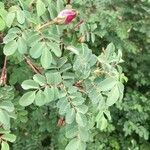Shrubs 1–2 m tall. Branchlets purple-brown, slender; prickles in pairs below leaves, and scattered, yellow, terete, straight, to 1 cm, stout, gradually tapering below to a broad base. Leaves including petiole 3–4 cm; stipules mostly adnate to petiole, free parts ovate, margin glandular, apex acute; rachis and petiole glabrous but very sparsely small prickly; leaflets 5–9, suborbicular, obovate, or broadly elliptic, 6–20 × 4–12 mm, glabrous or abaxially sparsely puberulous along veins, base subrounded or cuneate, margin simply serrate at upper part, near base entire, apex rounded-obtuse, rarely acute. Flowers solitary, rarely 2 or 3 and fasciculate, 3.5–5 cm in diam.; pedicel 1–1.5 cm, glabrous or glandular-pubescent; bracts ovate, margin glandular serrate, midvein and lateral veins abaxially conspicuous. Hypanthium subglobose or ovoid, glabrous or glandular puberulous. Sepals 5, triangular-lanceolate, abaxially glandular-pubescent, adaxially densely puberulous, margin entire, apex elongate. Petals 5, reddish or rose, broadly obovate, base cuneate, apex emarginate. Styles free, shorter than stamens, pubescent. Hip nodding, bright-red, subglobose or ovoid, 1.5–2 cm in diam., glabrous, with persistent, spreading sepals. Fl. Jun–Jul, fr. Jul–Sep.
More
A woody shrub. It grows 2 m high and spreads 2 m wide. Young reddish shoots emerge directly from the roots. The shoots can arch over or trail along the ground. The leaves are small and greyish blue. The flowers are small and have a scent. The fruit are pear shaped orange-red hips. The young shoots are eaten.
It is a cool temperate plant. In the Indian Himalayas it grows between 2,000-4,000 m above sea level. It suits cold arid places. In Tibet it grows between 2,000-4,500 m above sea level. It suits hardiness zones 4-9.
More
Rocky mountain slopes in arid areas, grassy places, forest edges, among forest, in scrub, in valleys or near farmlands; at elevations from 1,500-4,500 metres.
Can be grown by cuttings or seedlings. Seeds needs scarification.

